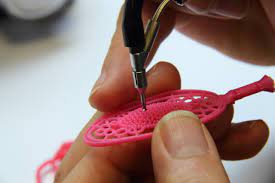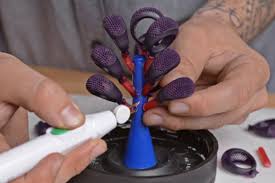Wax Setter
SECTOR: GEMS & JEWELLERY
SUB-SECTOR: Cast and Diamonds-Set Jewellery
OCCUPATION: Wax setting
REFERENCE ID: G&J/Q1701
ALIGNED TO: NCO-2004/7313.30
Wax setter: Wax setter sets diamonds and gemstones in wax replica of the
jewellery piece for the purpose of casting.
Brief Job Description: The individual works with numerous hand tools to set
diamonds and gemstones as per design. The individual is responsible for
delivering: levelled, damage-free and secured setting of stones while maintaining
its brilliance.
Personal Attributes: The job requires the individual to have: attention to details;
good eyesight; steady hands and ability to work in a process driven team for long
hours in sitting position. The individual is expected to have a high level of integrity
in dealing with diamonds and gemstones.
Qualifications Pack For Wax Setter
Keywords /Terms Description
Sector Sector is a conglomeration of different business operations having similar
business and interests. It may also be defined as a distinct subset of the economy
whose components share similar characteristics and interests.
Sub-sector Sub-sector is derived from a further breakdown based on the characteristics and
interests of its components.
Occupation Occupation is a set of job roles, which perform similar/ related set of functions
in an industry.
Job role Job role defines a unique set of functions that together form a unique
employment opportunity in an organisation.
Occupational Standards
(OS)
OS specify the standards of performance an individual must achieve when
carrying out a function in the workplace, together with the knowledge and
understanding they need to meet that standard consistently. Occupational
Standards are applicable both in the Indian and global contexts.
Performance Criteria Performance criteria are statements that together specify the standard of
performance required when carrying out a task.
National Occupational
Standards (OS)
NOS are occupational standards which apply uniquely in the Indian context.
Qualifications Pack (QP) QP comprises the set of OS, together with the educational, training and other
criteria required to perform a job role. A QP is assigned a unique qualifications
pack code.
Unit Code Unit code is a unique identifier for an Occupational Standard, which is denoted
by an ‘N’
Unit Title Unit title gives a clear overall statement about what the incumbent should be
able to do.
Description Description gives a short summary of the unit content. This would be helpful to
anyone searching on a database to verify that this is the appropriate OS they are
looking for.
Scope Scope is a set of statements specifying the range of variables that an individual
may have to deal with in carrying out the function which have a critical impact
on quality of performance required.
Knowledge and
Understanding
Knowledge and understanding are statements which together specify the
technical, generic, professional and organisational specific knowledge that an
individual needs in order to perform to the required standard.
Organisational Context Organisational context includes the way the organisation is structured and how
it operates, including the extent of operative knowledge managers have of their
relevant areas of responsibility.
Technical Knowledge Technical knowledge is the specific knowledge needed to accomplish specific
designated responsibilities.
Core Skills/ Generic
Skills
Core skills or generic skills are a group of skills that are the key to learning and
working in today’s world. These skills are typically needed in any work
environment in today’s world. These skills are typically needed in any work
environment. In the context of the OS, these include communication related
skills that are applicable to most job roles
Keywords /Terms Description
NOS National Occupational Standard(s)
NSQF National Skills Qualifications Framework
QP Qualifications Pack
Set diamonds and stones in the wax models
Unit Code G&J/ N 1701
Unit Title
(Task) Set diamonds and stones in the wax models
Description This OS unit is about setting diamonds and gemstones with hardness above 9 on
mohs in the wax pieces by using hand tools, wax soldering iron and advance
techniques
Scope This unit/task covers the following:
Reading the job sheet and identifying raw materials
Cleaning and checking each wax piece
Setting the diamonds and gemstones in the wax piece
Controlling damage to stones
Achieving productivity
Achieving quality standards
Performance Criteria(PC) w.r.t. the Scope
Element Performance Criteria
Reading job sheet and
identifying raw materials
To be competent, the user/individual on the job must be able to:
PC1. Follow design specifications in terms of type of jewellery as well as
number, weight and size of diamonds and gemstones required
PC2. Follow and apply the working procedures desired for the type of waxes
as per standard operating procedures
PC3. Match the size of diamonds and gemstones received against the
requirement mentioned in the job sheet
Cleaning and checking
each wax piece
PC4. Inspect all wax patterns for signs of defects or blemishes that will be
transported into the metal cast jewellery
PC5. Clean and smooth all wax patterns in preparation for setting the
diamond and stones into the wax
PC6. In case of wax pieces which are defective bring it to supervisors’ notice
Setting the diamonds and
gemstones in the wax
piece
PC7. Select tools, materials and equipment in accordance with the job
specifications and type of setting
PC8. Use the advanced techniques for setting such as prong, channel, bead,
flush, bezel, pave, micro-pave, invisible, etc. for setting small and tiny
diamonds and gemstones (less than 1 mm size) use Pave and Micro Pave
setting technique, where a bead is raised and created in between predrilled holes. Create these beads in such a way to hold the stones
together in a very close and uniform way
PC9. Press the diamond and gemstones at the required levels using hand tools
PC10. Use the specified soldering/locking technique required for the design of
jewellery
PC11. Finish the wax pieces by correcting the surface for defects
PC12. Secure setting of diamonds and gemstones
Set diamonds and stones in the wax models
PC13. Provide finishing to wax pieces as per design requirement and laid down
standards
Controlling damage to
stones
PC14. Handle diamonds and precious stones with care
PC15. Minimise or avoid damage to diamonds and precious stones during
setting process
PC16. Maintain zero defect wax pieces in the process before setting
PC17. Select right size of diamonds and gemstone for setting in the wax piece
Achieving productivity PC18. Deliver in time the product to tree-making and casting processes
PC19. Set number of stones or carat per day against target given
Achieving quality
standards
PC20. Rework as per QC suggestions on the defective wax pieces
PC21. Return completed wax piece to supervisor
PC22. Ensure timely delivery
PC23. Maintain accurate level of the stones in the wax piece
PC24. Produce number of Quality Control approved wax pieces’ set
PC25. Keep the work station, machine and tools clean
PC26. Keep all the tools in an organised manner
Knowledge and Understanding (K)
A. Organizational Context The user/individual on the job needs to know and understand:
KA1. Company’s policies on: quality and delivery standards, safety and
hazards, integrity and personnel management
KA2. Non–disclosure of “confidential information” provided by the company
either orally or in writing marked as confidential
KA3. Liability arising out of loss, theft, or inadvertent disclosure of confidential
information
KA4. Work flow involved in jewellery manufacturing process of the company
KA5. Importance of the individual’s role in the workflow
KA6. Reporting structure
B. Technical Knowledge KB1. Different types of basic and advance setting techniques for diamond and
gemstones such as pave, micro pave, invisible, etc.
KB2. How to Solder accurately in order to fix the stones securely without
damaging the wax
KB3. Quality standards as per design or company guidelines
KB4. Uses of different types of tools for different end results
KB5. Use of 10X loupe or 5X optivisor
KB6. Use and maintain tools
KB7. Potential work hazards, particularly, when using wax soldering iron and
hand tools
KB8. Types of wax and their properties
KB9. Mismatch of diamond colour, size & weight with respect to job sheet
Set diamonds and stones in the wax models
The user/ individual on the job needs to know and understand how to:
SA1. Fill the requisition slip for tools and materials required
Reading Skills
SA2. Read job sheets
SA3. Read company rules and compliance documents
SA4. Read and understand nondisclosure policies of the company
SA5. Read and measure millimeter size by gauge tool and ring size by specified
ring size stick
Oral Communication (Listening and Speaking skills)
SA6. Share work load as required
SA7. Follow supervisor’s instructions
SA8. Report to supervisor about mismatch and shortage in diamonds
B. Professional Skills Decision Making
SB1. Decide on the proper size of the diamonds before carrying out setting
Plan and Organize
SB2. Organise required toolkit at the work bench for better time management
Customer Centricity
N. A.
Problem Solving
SB3. Resolve issues in wax setting such as mismatch and sizes of diamonds
Analytical Thinking
SB4. Increase productivity
Critical thinking
SB5. Increase efficiency based on past work experience
Set diamonds and stones in the wax models
NOS Version Control
NOS Code G&J/N1701
Credits (NSQF) TBD Version number 1.0
Industry Gems & Jewellery Drafted on 28/08/2016
Industry Sub-sector
Cast and Diamonds – Set
Jewellery Last reviewed on 18/10/2016
Occupation Wax setting Next review date 17/10/2019
Coordinate with others
Unit Code G&J/ N9901
Unit Title
(Task) Coordinate with others
Description This OS unit is about communicating with colleagues, seniors and outside parties in
order to achieve the deliverables on schedule
Scope This unit/task covers the following:
Interacting with supervisor
Interacting with colleagues within and outside the department
Interacting with outside parties
Performance Criteria(PC) w.r.t. the Scope
Element Performance Criteria
Interacting with
supervisor
To be competent, the user/individual on the job must be able to
PC1. Coordinate for receiving work instructions and raw materials from reporting
supervisor
PC2. Communicate to the reporting supervisor about process flow improvements,
product defects received from previous process, repairs and maintenance of
tools and machinery as required
PC3. Communicate to reporting supervisor about operation details and hazards
PC4. Interact with supervisor regarding compliance of company policy and rules
Interacting with
colleagues and other
departments
PC5. Coordinate with colleagues to share work, as per the workload
PC6. Communicate and discuss work flow related difficulties in order to find
solutions with mutual agreement
PC7. Coordinate and receive feedback from quality control department
PC8. Coordinate for putting team goals over individual goals
PC9. Resolve conflicts by communicating with colleagues and other departments
PC10. Coordinate with colleagues regarding multitasking in other departments with
requirements
Interacting with
outside parties
PC11. Adhere to nondisclosure policy of the company in all outside coordination
Knowledge and Understanding (K)
A. Organizational
Context
The user/individual on the job needs to know and understand:
KA1. Company’s policies on: preferred language of communication, reporting and
escalation policy, quality delivery standards, and personnel management
KA2. Company’s policies on non-disclosure of “confidential information” provided
by the company either orally or in writing marked as confidential
KA3. Liability arising out of loss, theft or inadvertent disclosure of confidential
information
KA4. Reporting structure
Coordinate with others
B. Technical
Knowledge
KB1. Various categories of people that one is required to communicate and
coordinate within the organization
KB2. Importance of effective communication in the workplace
KB3. Importance of teamwork in organization and individual success
KB4. Various components of effective communication
KB5. Key elements of active listening
KB6. Barriers to effective communication
KB7. Importance of avoiding casual expletives and unpleasant terms while
communicating professional circles
KB8. Common reasons for interpersonal conflict
KB9. Expressing and addressing grievances appropriately and effectively
KB10. What constitutes disciplined behavior for a working professional
Skills (S) [Optional]
A. Core skills/
Generic skills
Writing Skills
The user/ individual on the job needs to know and understand how to:
SA1. Write instructions, remarks, job sheets, basic information, technical details
etc. in preferred local language of communication and English.
Reading Skills
SA2. Read preferred language of communication as prescribed by the company
SA3. Read job sheets and interpret technical details mentioned in the job sheet
Oral Communication (Listening and Speaking skills)
SA4. Discuss task lists, schedules, and work-loads with co-workers
SA5. Be a good listener
SA6. Be effective in communicating the issues faced to the supervisor
SA7. Avoid using jargon, slang or acronyms when communicating
B. Professional Skills Decision Making
SB1. Spot and communicate potential areas of disruptions to work process and
report the same
SB2. Report to supervisor and or to deal with a colleague individually, depending
on the type of concern
Plan and Organize
SB3. Collate information and communicate in a manner that is clear and
comprehensive to colleagues and supervisor
Customer Centricity
SB4. Convey accurate information to all internal as well as external customers (or
right information to right person)
Coordinate with others
Problem Solving
SB5. How to handle critical situations caused due to communication issues at
workplace and solve problems without blaming others
Analytical Thinking
SB6. Analyse the work processes by interacting with others and adopting best
practices
SB7. Use prior experience to observe and reflect for development of ideas
Critical Thinking
SB8. Think through the problem, evaluate the possible solution(s) and suggest an
optimum /best possible solution(s)
SB9. Deal with clients lacking the technical background to solve the problem on
their own
SB10. Spot process disruptions and delays and report and communicate with
solutions
SB11. Identify immediate or temporary solutions to resolve delays
SB12. Apply, analyze, and evaluate the information gathered from observation,
experience, reasoning, or communication, as a guide to thought and action
Maintain health and safety at workplace
Unit Code G&J/N9902
Unit Title
(Task) Maintain health and safety at workplace
Description This OS unit is about being aware of, communicating and taking steps towards
minimizing potential hazards and dangers of accidents on the job and maintaining
occupational health and safety
Scope This unit/task covers the following:
Health and safety in work area
Fire safety
Emergencies, rescue and first aid procedures
Performance Criteria(PC) w.r.t. the Scope
Element Performance Criteria
Health and safety in
work area
To be competent, the user/individual on the job must be able to:
PC1. Identify and use appropriate protective clothing/equipment for specific tasks
and work
PC2. Identify hazardous job activities in his/her job and communicate the possible
causes of risks or accidents in the workplace
PC3. Carry out safe working practices while dealing with hazards to ensure safety
of self and others
PC4. Identify and avoid doing any tasks or activities in a bad working position
PC5. Practice appropriate working postures to minimise occupational health
related issues
Fire safety PC6. Use the appropriate fire extinguishers on different types of fire
PC7. Demonstrate rescue techniques applied during fire hazard
PC8. Demonstrate good housekeeping in order to prevent fire hazards
PC9. Demonstrate the correct use of any fire extinguisher
Emergencies, rescue
and first aid
procedures
PC10. Administer appropriate first aid procedure to victims wherever required eg.in
case of bleeding, burns, choking, electric shock etc.
PC11. Respond promptly and appropriately to an accident situation or medical
emergency
PC12. Participate in emergency procedures such as raising alarm, safe evacuation,
correct means of escape, correct assembly point etc.
Knowledge and Understanding (K)
A. Organizational
Context
The user/individual on the job needs to know and understand:
KA1. Company’s policies on: safety and hazards and personnel management
KA2. Names and location of documents that refer to health and safety in work
place.
KA3. Reporting structure
B. Technical
Knowledge
KB1. Meaning of “hazard’s” and risks
KB2. Health and safety hazards commonly present in the work place and related
precautions
Maintain health and safety at workplace
KB3. Various dangers associate with use of electrical equipment
KB4. Preventative and remedial actions to be taken in case of exposure to toxic
material
KB5. Methods of accident prevention
KB6. How different chemicals react and what could be the danger from them
KB7. How to use machines and tools without suffering bodily harm
KB8. Importance of using protective clothing/ equipment while working
KB9. Precautionary activities to prevent the fire accident
KB10. Various causes of fire
KB11. Techniques of using different fire extinguishers
KB12. Different materials used for extinguishing fire
KB13. Rescue techniques applied during a fire hazard
KB14. Various types of safety signs and what they mean
KB15. Appropriate basic first aid treatment relevant to condition e.g. bleeding,
minor burns, eye injuries etc.
KB16. Potential impact to a person who is moved incorrectly
Skills (S) [Optional]
A. Core Skills/
Generic Skills
Writing Skills
The individual on the job needs to know and understand how to:
N.A.
Reading Skills
SA1. Read and comprehend basic content to read labels, charts, signage’s
SA2. Read and comprehend basic English to read manuals of operations
Oral Communication (Listening and Speaking skills)
SA3. Effectively communicate the risk
B. Professional Skills Decision Making
SB1. Report potential sources of danger
SB2. Follow the relevant prescribed procedure in the event of an accident
SB3. Wear appropriate safety gear to avoid an accident
Plan and Organize
SB4. Learn from past mistakes regarding use of hazardous machines or chemicals
Customer Centricity
N. A.
Problem Solving
SB5. Adhere to and guide others to follow prescribed procedures related to
occupational health and safety
Analytical Thinking
SB6. Analyse untoward incidents from the past and implement correct use of
machines, tools or hazardous chemicals
Critical Thinking
SB7. Critically analyse the processes carried out by self and by colleagues in the
department to spot potential hazards and safety issues
CRITERIA FOR ASSESSMENT OF TRAINEES
Job Role Wax Setter
Qualification Pack G&J/Q1701
Sector Skill Council Gem & Jewellery
Guidelines for Assessment
- Criteria for assessment for each Qualification Pack will be created by the Sector Skill Council. Each Performance
Criteria (PC) will be assigned marks proportional to its importance in NOS. SSC will also lay down proportion of
marks for Theory and Skills Practical for each PC. - The assessment for the theory part will be based on knowledge bank of questions created by the SSC.
- Individual assessment agencies will create theory question papers for candidates at every examination/training
centre. (As per assessment criteria below) - Individual assessment agencies will create practical tests for skill evaluation for candidates at every
examination/training centre. (As per assessment criteria below) - To pass the Qualification Pack, every candidate should score a minimum 50% of aggregate marks to successfully
clear the assessment. - In case of successfully passing only certain number of NOSs, the candidate is eligible to take subsequent
assessment on the balance NOSs to pass the Qualification Pack.
Assessment
outcomes
Assessment Criteria for
outcomes
Total Marks (30+120) Out of Theory Skills
Practical
- G&J/N1701
Set diamonds
and stones in
the wax models
PC1. Follow design specifications
in terms of type of jewellery as
well as number, weight and size
of diamonds and gemstones
required
110
5 1 4
PC2. Follow and apply the
working procedures desired for
the type of waxes as per
standard operating procedures
5 1 4
PC3. Match the size of diamonds
and gemstones received against
the requirement mentioned in
the job sheet
5 1 4
PC4. Inspect all wax patterns for
signs of defects or blemishes that
will be transported into the
metal cast jewellery
5 1 4









